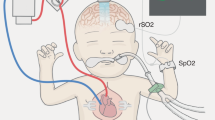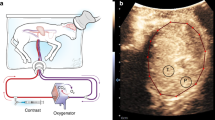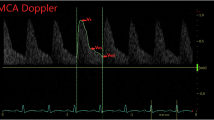Abstract
Cardiac output is a determinant of systemic blood flow and its measurement may therefore be a useful indicator of abnormal hemodynamics and tissue oxygen delivery. The purpose of this study was to investigate in very premature newborn infants the relationships between cardiac output (left and right ventricular outputs), systemic blood pressure, peripheral blood flow (PBF) and two indicators of cerebral oxygen delivery (cerebral electrical activity and cerebral fractional oxygen extraction (CFOE)). This was a prospective observational study performed on 40 infants of less than 30 wk gestation. Digital electroencephalograms (EEGs) were recorded for one hour every day during the first four days after birth and subjected to qualitative and quantitative analysis. Left and right ventricular outputs, mean blood pressure (MBP), CFOE, PBF and arterial blood gases were measured at the same time. Within the ranges studied, there was no apparent relationship between left or right ventricular output (RVO), PBF and indicators of cerebral perfusion (cerebral electrical activity and CFOE). The EEG was normal in infants with low left and right ventricular outputs (<150 mL/kg/min) and MBP > 30 mm Hg. Infants with low cardiac output and normal MBP seem able to maintain cerebral perfusion, possibly through vasodilatation of the cerebral microvasculature.
Similar content being viewed by others
Log in or create a free account to read this content
Gain free access to this article, as well as selected content from this journal and more on nature.com
or
Abbreviations
- CFOE:
-
cerebral fractional oxygen extraction
- LVO:
-
left ventricular output
- MBP:
-
mean blood pressure
- PaCO2:
-
arterial carbon dioxide tension
- PBF:
-
peripheral blood flow
- RVO:
-
right ventricular output
References
Lou HC, Lassen NA, Friis-Hansen B 1979 Impaired autoregulation of cerebral blood flow in the distressed newborn infant. J Pediatr 94: 118–121
Tyszczuk L, Meek J, Elwell C, Wyatt JS 1998 Cerebral blood flow is independent of mean arterial blood pressure in preterm infants undergoing intensive care. Pediatrics 102: 337–341
Kluckow M, Evans N 1996 Relationship between blood pressure and cardiac output in preterm infants requiring mechanical ventilation. J Pediatr 129: 506–512
Kissack CM, Garr R, Wardle SP, Weindling AM 2004 Cerebral fractional oxygen extraction in very low birth weight infants is high when there is low left ventricular output and hypocarbia but is unaffected by hypotension. Pediatr Res 55: 400–405
Wardle SP, Yoxall CW, Weindling AM 2000 Determinants of cerebral fractional oxygen extraction using near infrared spectroscopy in preterm neonates. J Cereb Blood Flow Metab 20: 272–279
Ichord RN, Kirsch JR, Koehler RC, Traystman RJ 1999 Cerebral anoxia: experimental view. In: Niedermeyer E, Lopes da Silva FH (eds) Electroencephalography: basic principles, clinical applications, and related fields. Williams & Wilkins, Baltimore, pp 432–444
Wakayama K, Ogawa T, Goto K, Sonoda H 1993 Development of ultradian rhythm of EEG activities in premature babies. Early Hum Dev 32: 11–30
Scher MS, Johnson MW, Holditch-Davis D, Scher MS, Johnson MW, Holditch-Davis D 2005 Cyclicity of neonatal sleep behaviors at 25 to 30 weeks' postconceptional age. Pediatr Res 57: 879–882
Victor S, Appleton RE, Beirne M, Marson AG, Weindling AM 2005 Spectral analysis of electroencephalography in premature newborn infants: normal ranges. Pediatr Res 57: 336–341
Jasper HH 1958 The Ten - Twenty Electrode System of the International Federation. Electroencephalogr Clin Neurophysiol 10: 371–375
Biagioni E, Bartalena L, Biver P, Pieri R, Cioni G 1996 Electroencephalographic dysmaturity in preterm infants: a prognostic tool in the early postnatal period. Neuropediatrics 27: 311–316
Yoxall CW, Weindling AM, Dawani NH, Peart I 1995 Measurement of cerebral venous oxyhemoglobin saturation in children by near-infrared spectroscopy and partial jugular venous occlusion. Pediatr Res 38: 319–323
Wardle SP, Yoxall CW, Crawley E, Weindling AM 1998 Peripheral oxygenation and anemia in preterm babies. Pediatr Res 44: 125–131
Alverson DC 2000 Cardiac Output. In: Skinner JR, Alverson DC, Hunter S (eds) Echocardiography for the neonatologist. Churchill Livingstone, London, pp 121–132
Alverson DC, Eldridge MW, Johnson JD, Aldrich M, Angelus P, Berman W Jr 1984 Noninvasive measurement of cardiac output in healthy preterm and term newborn infants. Am J Perinatol 1: 148–151
The International Neonatal Network 1993 The CRIB (clinical risk index for babies) score: a tool for assessing initial neonatal risk and comparing performance of neonatal intensive care units. Lancet 342: 193–198
Cunningham S, Symon AG, Elton RA, Zhu C, McIntosh N 1999 Intra-arterial blood pressure reference ranges, death and morbidity in very low birthweight infants during the first seven days of life. Early Hum Dev 56: 151–165
Fowlie PW, Davis PG 2002 Prophylactic intravenous indomethacin for preventing mortality and morbidity in preterm infants. The Cochrane Database of Systematic Reviews, Issue 3, CD000174. DOI: 10.1002/14651858.CD000174
Scher MS 1999 Electroencephalography of the newborn: normal and abnormal features. In: Niedermeyer E, Lopes da Silva FH (eds) Electroencephalography: basic principles, clinical applications, and related fields. Williams and Wilkins, Baltimore, pp 896–946
Eyre JA, Nanei S, Wilkinson AR 1988 Quantification of changes in normal neonatal EEGs with gestation from continuous five-day recordings. Dev Med Child Neurol 30: 599–607
Hayakawa M, Okumura A, Hayakawa F, Watanabe K, Ohshiro M, Kato Y, Takahashi R, Tauchi N 2001 Background electroencephalographic (EEG) activities of very preterm infants born at less than 27 weeks gestation: a study on the degree of continuity. Arch Dis Child Fetal Neonatal Ed 84: F163–F167
Biagioni E, Boldrini A, Bottone U, Pieri R, Cioni G 1996 Prognostic value of abnormal EEG transients in preterm and full-term neonates. Electroencephalogr Clin Neurophysiol 99: 1–9
Marret S, Parain D, Menard JF, Blanc T, Devaux AM, Ensel P, Fessard C, Samson-Dollfus D 1997 Prognostic value of neonatal electroencephalography in premature newborns less than 33 weeks of gestational age. Electroencephalogr Clin Neurophysiol 102: 178–185
Victor S, Appleton RE, Beirne M, Marson AG, Weindling AM 2005 Effect of carbon dioxide on background cerebral electrical activity and fractional oxygen extraction in very low birth weight infants just after birth. Pediatr Res 58: 579–585
Victor S, Weindling AM, Appleton RE, Beirne M, Marson AG 2006 Relationship between blood pressure, electroencephalograms, cerebral fractional oxygen extraction and peripheral blood flow in very low birth weight newborn infants. Pediatr Res 59: 314–319
Evans N, Kluckow M 1996 Early determinants of right and left ventricular output in ventilated preterm infants. Arch Dis Child Fetal Neonatal Ed 74: F88–F94
Kluckow M, Evans N 2000 Superior vena cava flow in newborn infants: a novel marker of systemic blood flow. Arch Dis Child Fetal Neonatal Ed 82: F182–F187
Lundstrom K, Pryds O, Greisen G 2000 The haemodynamic effects of dopamine and volume expansion in sick preterm infants. Early Hum Dev 57: 157–163
Laubscher B, van Melle G, Fawer CL, Sekarski N, Calame A 1996 Haemodynamic changes during high frequency oscillation for respiratory distress syndrome. Arch Dis Child Fetal Neonatal Ed 74: F172–F176
van Bel F, Walther FJ 1990 Myocardial dysfunction and cerebral blood flow velocity following birth asphyxia. Acta Paediatr Scand 79: 756–762
Jensen A, Garnier Y, Berger R, Jensen A, Garnier Y, Berger R 1999 Dynamics of fetal circulatory responses to hypoxia and asphyxia. Eur J Obstet Gynecol Reprod Biol 84: 155–172
Author information
Authors and Affiliations
Corresponding author
Additional information
Funding by Newborn Appeal, Liverpool Women's Hospital, Liverpool, L8 7SS
Rights and permissions
About this article
Cite this article
Victor, S., Appleton, R., Beirne, M. et al. The Relationship between Cardiac Output, Cerebral Electrical Activity, Cerebral Fractional Oxygen Extraction and Peripheral Blood Flow in Premature Newborn Infants. Pediatr Res 60, 456–460 (2006). https://doi.org/10.1203/01.pdr.0000238379.67720.19
Received:
Accepted:
Issue date:
DOI: https://doi.org/10.1203/01.pdr.0000238379.67720.19
This article is cited by
-
A Preterm Physiologically Based Pharmacokinetic Model. Part I: Physiological Parameters and Model Building
Clinical Pharmacokinetics (2020)
-
Changes in hemodynamics, cerebral oxygenation and cerebrovascular reactivity during the early transitional circulation in preterm infants
Pediatric Research (2019)
-
Effect of permissive hypercapnia on background cerebral electrical activity in premature babies
Pediatric Research (2014)
-
Relationship between systemic blood flow, blood pressure, inotropes, and aEEG in the first 48 h of life in extremely preterm infants
Pediatric Research (2013)



